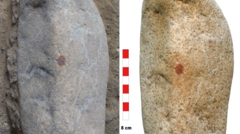Scientists in Spain have made a groundbreaking discovery that hints at Neanderthals’ capacity for artistic expression. Researchers unearthed the oldest known full human fingerprint on a rock resembling a human face, indicating that a Neanderthal man may have created art around 43,000 years ago by dipping his finger in red pigment to paint a nose on the pebble. This pebble was found in the San Lázaro rock shelter in Segovia, prompting a reevaluation of Neanderthals’ symbolic behavior and artistic capabilities.
The research team, led by Prof. María de Andrés-Herrero from the University of Complutense in Madrid, began excavating the site five years ago. They discovered the stone beneath 1.5 meters (about 5 feet) of sediment attributed to Neanderthal habitation. Initially surprised by the larger size of the stone—compared to other artifacts at the site—and the distinct red dot in the center, the researchers sought confirmation regarding the pigment source. With support from Spain's scientific police, they conducted detailed analyses, eventually identifying a human fingerprint on the pebble, which they believe belonged to an adult male.
While archaeologist David Álvarez Alonso noted that the lack of comparative Neanderthal fingerprints makes it difficult to confirm with certainty, the findings led Spanish official Gonzalo Santonja to declare the pebble the oldest painted portable object in Europe, and the sole painted work attributed to Neanderthals. Prof. de Andrés-Herrero emphasized the significance of their research, which supports the notion that Neanderthals possessed symbolic thought, marking a pivotal moment in the understanding of their cultural capabilities.
Notably, the fingerprint was found in a context that suggests it served an artistic purpose rather than a utilitarian one, as the red pigment is not naturally found in the shelter, implying it was deliberately brought there by a Neanderthal. Researchers theorize that the individual might have been drawn to the unique features of the stone and intentionally made his mark—an early form of creative expression. Their findings were published in the journal Archaeological and Anthropological Sciences, further solidifying the notion that Neanderthals were capable of producing symbolic art.


















